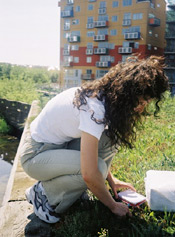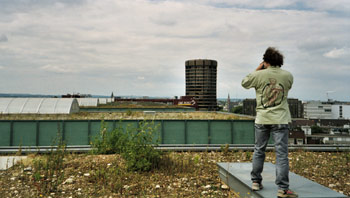Research in Switzerland
The only research going on into biodiversity on green roofs prior to 2002 was in Basel, Switzerland. Birds, Beetles and Spiders on green roofs was published in 2000 and gives details of the populations and activities of these groups on roofs. The research has lead to a change in the way roofs are laid.
The study found
- Importance of relief
- Vegetation is important especially localised plant communities on the roof where there are small hills. These provide many seeds.
- Areas of little vegetation are important for White Wagtail and some beetle species.
- Natural soil should be used, mixed in with the substrate. This allows for rapid colonisation and therefore greater biodiversity interest. The use of lava and other ‘produced’ materials should be avoided as they decrease biodiversity potential and are unsustainable.
- The need to have areas that retain water during dry periods adds to the variety on the roofs (in Luzern orchids have been found to have colonise certain roofs).
- The importance of providing larger stones and pieces of timber as give added humidity on the roofs for spiders and beetles. Birds make use of these structures for perching while searching food.
They are now contoured in Basel to maximise their benefits for biodiversity, primarily invertebrates. This report is soon to be followed up by a further study, which has been undertaken to compare the biodiversity of brown land near buildings with green roofs and the roofs themselves.
This report will be published soon.
Further details of both can be obtained from Stephan Brenneisen at s.brenneisen@hswzfh.ch
A summary English translation of the first report can be obtained from upstart@dusty.fsnet.co.uk
Study of invertebrates on green roofs – How roof design can maximize biodiversity in an urban environment
This research project investigated the invertebrate fauna of green roofs, focusing on the spider community in order to give information about the biodiversity and conservation potential of green roofs. This study was inspired by the black redstart biodiversity action plan and was part of an Msc Conservation degree at UCL.
The study found that existing green roofs provide habitat for a diverse spider community, the 59 species collected from the study sites represents 9% of the total UK and 26% of the Greater London spider fauna. It was also found that green roofs not only provide habitat for common species but they also support Nationally Rare and Scarce and locally uncommon species as well. There were two Nationally Scarce species found in the sample namely Pardosa agrestis (Lycosidae) with Nb status and Bianor aurocinctus, (Salticidae) with Na status. None of these species have ever been recorded in the Greater London area before this study. In addition other spiders such as Steatoda phalerata (Theridiidae) were also the first recording to Greater London and Erigone alteris (Linyphiidae) was not only the first recording in Greater London but it has never been recorded in the South of England before! Surprisingly there were even wetland species found on green roofs such as Arctosa leopardus (Lycosidae) which is also first recording in the Greater London area.
The study has also investigated how the different roof design affects the species community of green roofs. While most surveyed roofs were constructed with sedum matting, as the design and environmental factors were different on each roof, the sampled roofs were dissimilar in character. It was found that there was a highly significant statistical difference between the number of spiders found on each roof. The highest number of species were found on roofs which had deeper substrate and had varied structural and vegetation diversity.
Fig.1 THE HIERARCHY OF FACTORS AFFECTING SPECIES COMPOSITION
As green roofs could play and important part in the mitigation process of brownfield sites, the study has investigated whether current green roof design could serve as suitable habitat replacement for the lost biodiversity of these rich habitats. The research showed that the species composition of green roofs with sedum matting is different to that of brownfield sites. Green roofs however, still play a vital role in the mitigation process of brownfield sites, especially if local substrate is used on green roofs, sown either with local wildflower mix or left to be colonised naturally.
The study concluded that green roofs have great biodiversity potential. Green roofs already support a wide range of spider and invertebrate community. The presence of these invertebrates reflects the abundance of lower trophic level organisms which most likely have an impact on the higher tropic levels as food source, e.g. for vertebrates. The biodiversity of green roofs could be even more enhanced by appropriate roof design. As the study demonstrated that substrate is a vital factor explaining species assemblage on green roofs, it is suggested that substrate of the original site is either recycled or local substrate is used on roofs. By increasing structural diversity green roofs will cater for an even wider range of species.
This research was undertaken by Gyongyver Kadas.
For a copy of the full report contact g.kadas@btinternet.com
Green Roofs - a study of their benefits and barriers to their installation, in London.
This study is about Green Roofs, their benefits, the policy work that supports them and the barriers to their installation. Green roofs are prevalent in many European city's but their numbers in London are still small. Green roofs provide not only benefits to wildlife, but to the city's environment and the people who live and work in them, and while not a development panacea they non the less provide an exciting opportunity for enhancing the sustainability of both new and existing buildings.
Postal questionnaires were conducted with the major stakeholder groups in the development process; architects, developers, engineers and planners. Each group were asked if they were aware of the benefits of green roofs and what they saw as the chief constraints on their installation.
Of the 280 people contacted, 75 responded. Of these 81% said they were aware of green roofs. In addition to this 80% of the respondents agreed that having a green roof on a building would improve the buildings aesthetics and 92% of respondents agreed that there would be benefits to biodiversity in having a green roof.
When asked whether there were "few constraints" surrounding the establishment of green roofs, overall 50% disagreed. Of the different constraints presented to the respondents a lack of awareness on the part of developers was shown to be the strongest, followed by lack of awareness of architects, lack of public demand and concerns of investors and finally the physical structure of buildings. In addition to those constraints presented in the questionnaire, "cost or maintenance", "lack of political drivers" and "a general lack of awareness" were also cited.
The results showed that while many people were aware of their benefits, they were not yet publicised widely enough to become mainstream. If green roofs are to become more widespread in London then there needs to be more publicity to promote their benefits. Mitigation and planning conditions on new developments should promote green roofs as an environmental gain.
This research carried out by Adam Ingleby.
For a copy of the full report contact aingleby@westminster.gov.uk


Gyongyver Kadas & Stephan Brenneisen on research field trips.
